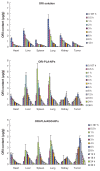RGD-modified poly(D,L-lactic acid) nanoparticles enhance tumor targeting of oridonin
- PMID: 22275836
- PMCID: PMC3263413
- DOI: 10.2147/IJN.S27581
RGD-modified poly(D,L-lactic acid) nanoparticles enhance tumor targeting of oridonin
Abstract
Objective: The purpose of this study was to develop an active targeting strategy to improve the therapeutic antitumor efficacy of oridonin (ORI), the main active ingredient in the medicinal herb Rabdosia rubescens.
Methods: A modified spontaneous emulsification solvent diffusion method was used to prepare the ORI-loaded atactic poly(D,L-lactic acid) nanoparticles (ORI-PLA-NPs). Surface cross-linking with the peptide Arg-Gly-Asp (RGD) further modified the ORI-PLA-NPs, generating ORI-PLA-RGD-NPs. The NPs were characterized and release experiments were performed in vitro. The pharmacokinetics, tissue distribution, and antitumor activity of the NPs were studied in mice bearing hepatocarcinoma 22 (H22)-derived tumors.
Results: The ORI-PLA-NPs and ORI-PLA-RGD-NPs were smooth, sphere-like, and relatively uniform in size. The RGD surface modification slightly increased the mean particle size (95.8 nm for ORI-PLA-NPs versus 105.2 nm for ORI-PLA-RGD-NPs) and considerably altered the surface electrical property (-10.19 mV for ORI-PLA-NPs versus -21.95 mV for ORI-PLA-RGD-NPs), but it had no obvious influence on ORI loading (8.23% ± 0.35% for ORI-PLA-NPs versus 8.02% ± 0.38% for ORI-PLA-RGD-NPs), entrapment efficiency (28.86% ± 0.93% for ORI-PLA-NPs versus 28.24% ± 0.81% for ORI-PLA-RGD-NPs), or the release of ORI. The pharmacokinetic properties of free ORI were improved by encapsulation in NPs, as shown by increased area under the concentration-time curve (11.89 ± 0.35 μg·mL(-1) · h for ORI solution versus 22.03 ± 0.01 μg · mL(-1) · h for ORI-PLA-RGD-NPs) and prolonged mean retention time (2.03 ± 0.09 hours for ORI solution versus 8.68 ± 0.66 hours for ORI-PLA-RGD-NPs). In the tissue distribution study, more ORI targeted tumor tissue in the mice treated with ORI-PLA-RGD-NPs than with ORI-PLA-NPs or ORI solution. Consistent with these observations, ORI-PLA-RGD-NPs showed greater antitumor efficacy than ORI-PLA-RGD-NPs or ORI solution, as reflected by the decreased tumor growth and the prolonged survival time of mice bearing H22 tumors.
Conclusion: The tumor-targeting efficiency and subsequent antitumor efficacy of ORI is increased by incorporation into ORI-PLA-RGD-NPs.
Keywords: L-lactic acid); ORI; RGD; antitumor activity; nanoparticles; poly(D.
Figures









Similar articles
-
Oridonin from Rabdosia rubescens: An emerging potential in cancer therapy - A comprehensive review.Food Sci Nutr. 2024 Feb 1;12(5):3046-3067. doi: 10.1002/fsn3.3986. eCollection 2024 May. Food Sci Nutr. 2024. PMID: 38726411 Free PMC article. Review.
-
Studies on the oridonin-loaded poly(D,L-lactic acid) nanoparticles in vitro and in vivo.Int J Biol Macromol. 2007 Jan 30;40(2):153-8. doi: 10.1016/j.ijbiomac.2006.07.001. Epub 2006 Aug 8. Int J Biol Macromol. 2007. PMID: 16901536
-
RGD-conjugated PLA-PLL nanoparticles targeting to Bacp-37 breast cancer xenografts in vivo.J Nanosci Nanotechnol. 2011 Dec;11(12):10760-4. doi: 10.1166/jnn.2011.3945. J Nanosci Nanotechnol. 2011. PMID: 22408990
-
Antitumor activity of docetaxel-loaded polymeric nanoparticles fabricated by Shirasu porous glass membrane-emulsification technique.Int J Nanomedicine. 2013;8:2641-52. doi: 10.2147/IJN.S48214. Epub 2013 Jul 29. Int J Nanomedicine. 2013. PMID: 23935362 Free PMC article.
-
Solubility and Bioavailability Enhancement of Oridonin: A Review.Molecules. 2020 Jan 14;25(2):332. doi: 10.3390/molecules25020332. Molecules. 2020. PMID: 31947574 Free PMC article. Review.
Cited by
-
RGD-modified liposomes enhance efficiency of aclacinomycin A delivery: evaluation of their effect in lung cancer.Drug Des Devel Ther. 2015 Aug 11;9:4613-20. doi: 10.2147/DDDT.S85993. eCollection 2015. Drug Des Devel Ther. 2015. PMID: 26316700 Free PMC article.
-
Preparation and evaluation of the anti-cancer properties of RGD-modified curcumin-loaded chitosan/perfluorohexane nanocapsules in vitro.Heliyon. 2022 Jul 11;8(7):e09931. doi: 10.1016/j.heliyon.2022.e09931. eCollection 2022 Jul. Heliyon. 2022. PMID: 35865990 Free PMC article.
-
Enhancing cancer therapy: advanced nanovehicle delivery systems for oridonin.Front Pharmacol. 2024 Dec 3;15:1476739. doi: 10.3389/fphar.2024.1476739. eCollection 2024. Front Pharmacol. 2024. PMID: 39691396 Free PMC article. Review.
-
Polymeric Co-Delivery Systems in Cancer Treatment: An Overview on Component Drugs' Dosage Ratio Effect.Molecules. 2019 Mar 15;24(6):1035. doi: 10.3390/molecules24061035. Molecules. 2019. PMID: 30875934 Free PMC article. Review.
-
Oridonin from Rabdosia rubescens: An emerging potential in cancer therapy - A comprehensive review.Food Sci Nutr. 2024 Feb 1;12(5):3046-3067. doi: 10.1002/fsn3.3986. eCollection 2024 May. Food Sci Nutr. 2024. PMID: 38726411 Free PMC article. Review.
References
-
- Guan YZ, Wei TH. Clinical research on the oridonin injection for the interventional therapy of liver cancer. J Med Radiol Technol. 2005:236–243. Chinese.
-
- Ren KK, Wang HZ, Xie LP, et al. The effects of oridonin on cell growth, cell cycle, cell migration and differentiation in melanoma cells. J Ethnopharmacol. 2006;103(2):176–180. - PubMed
-
- Chen S, Gao J, Halicka HD, Huang X, Traganos F, Darzynkiewicz Z. The cytostatic and cytotoxic effects of oridonin (Rubescenin), a diterpenoid from Rabdosia rubescens, on tumor cells of different lineage. Int J Oncol. 2005;26(3):579–588. - PubMed
-
- Hsieh TC, Wijeratne EK, Liang JY, Gunatilaka AL, Wu JM. Differential control of growth, cell cycle progression, and expression of NF-kappaB in human breast cancer cells MCF-7, MCF-10A, and MDA-MB-231 by ponicidin and oridonin, diterpenoids from the Chinese herb Rabdosia rubescens. Biochem Biophys Res Commun. 2005;337(1):224–231. - PubMed
-
- Liu YQ, Mu ZQ, You S, Tashiro S, Onodera S, Ikejima T. Fas/FasL signaling allows extracellular-signal regulated kinase to regulate cytochrome c release in oridonin-induced apoptotic U937 cells. Biol Pharm Bull. 2006;29(9):1873–1879. - PubMed
Publication types
MeSH terms
Substances
LinkOut - more resources
Full Text Sources

